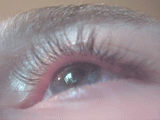Benign fasciculation
The term benign fasciculation (abbreviation BNF ; English benign fasciculation syndrome , BFS ) describes the occurrence of involuntary muscle twitching, in some cases also visible through the skin ( fasciculation ). The benign fasciculation does not per se have any disease value.
| Classification according to ICD-10 | |
|---|---|
| R25.3 | Fasciculation |
| ICD-10 online (WHO version 2019) | |
Fasciculations are common in healthy people, but can also occur as a result of motor neuron diseases. This makes them an important differential diagnosis for amyotrophic lateral sclerosis , for example . Typically, benign fasciculations are neither associated with atrophy nor with weakness of the muscles , nor with abnormal excitation processes in the motor neurons and usually occur after physical exertion. There are indications that spontaneous benign fasciculations can occur in a large part of the “healthy” population, particularly on the muscles of the hands and feet. It is therefore a diagnosis of exclusion without any disease value.
Individual evidence
- ↑ O. Hardiman et al. a .: Neurodegenerative Disorders: A Clinical Guide. Springer, 2011, ISBN 978-1-84996-010-6 , p. 154, (online)
- ^ AJ Larner: A Dictionary of Neurological Signs. Springer, 2010, ISBN 978-1-4419-7094-7 , p. 139, (online)
- ↑ JR Daube u. a .: Clinical Neurophysiology. Oxford University Press, 2009, ISBN 978-0-19-538511-3 , p. 431, (online)
- ↑ DD Mitsikostas u. a .: Fasciculation potentials in healthy people. In: Muscle Nerve. 1998 Apr; 21 (4), pp. 533-535., PMID 9533790 .
